Attitudes
While visitors primarily come to New Zealand for the scenery and natural environment, their most memorable moments are often the interactions with our people and cultures. Our manaakitanga and our local residents’ acceptance of visitors and willingness to host them is important to the success of the destination.
On this page
A broader level of community engagement in DM and planning is required than has been undertaken in the past and not all communities see tourism positively.
Some communities have become less receptive to visitors because of overcrowding, visitor behaviour and the cost of infrastructure that supports the tourism sector. For communities to continue to welcome and host visitors, the tourism sector and enabling partners need to work to address these challenges and retain the social licence to operate.
Local residents often make assumptions about visitors’ behaviour, expenditure, length of stay and so on. It is important that locals have access to data and insights to understand the value and benefits of the visitors coming to their place. Equally, it is important to address the evidence-based impacts of the visitors on the day-to-day lives of locals.
Each destination needs to establish their own definition of ‘community’. Engagement will vary according to the size and demographics of the community. Meaningful community engagement requires involving partners and stakeholders who are associated with the visitors, are affected by them (directly or indirectly), or have a common interest.
![]()
Well informed and engaged communities and stakeholders enhance the visitor experience and help build social licence.

Miles Holden, NorthShore-Auckland
Ask
- What mechanisms and processes are in place to engage actively and meaningfully with the community (including Māori/iwi/hapū)? (Engagement responsibilities on the Te Arawhiti website(external link))
- Have the views of the community been considered in the DM process?
- Are there some common interests that could assist with engagement and dialogue with fringe/less-connected groups?
- Are the tourism businesses committed to buying local and employing local?
- Can visitors contribute to/volunteer in community projects that deliver positive community outcomes?
- Are there incentives or benefits that support community-run tourism enterprises?
- Do we regularly have dialogue with the community, communicating accurate, consistent and timely information about the sector so they are well informed?
- Does the local community have a positive view of the tourism sector and its value to the community?
- How do we gather the local community views and address opportunities and issues?
- Can the local community freely access areas for recreation and leisure?
- Can the local community go about its day-to-day activities with relative ease alongside the visitors?
- Are some areas off-limits to visitors because of environmental/cultural significance; are these restrictions well explained?
- Are there partnerships between the public and private sectors?
- Are there programmes for developing community hosts and ambassadors?
- Do we encourage visitors to respect our destination and do we educate them about appropriate ways to behave? (See Tiakinewzealand.com(external link), drivesafe.org.nz(external link) and ‘Responsible Camping’.)
![]()
Raising awareness of the benefits of tourism amongst communities is helpful, and the benefits can include:
- Boosting regional economies
- Helping sustain local facilities and services
- Stimulating civic pride and strengthening communities
- Creating jobs
- Encouraging good management of the environment – visitors may choose destinations that are well managed, clean and exhibit good environmental ethics
- Celebrating local culture and language.

